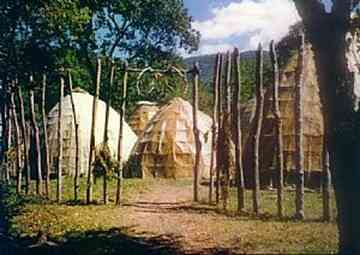The seeds of Wolf Creek Indian Village and Museum were sewn in May 1970, when highway construction crews encountered a Native American village site as they worked to re-locate the creek to make room for I-77.
 The village was last occupied at about the same time as the English gentry cornered King John of England at Runnymede and forced him into making concessions in the Magna Carta. As a result, the native peoples who lived in the region that would become Bland County, Va., more than 240 years after the Pilgrims landed at Plymouth Rock, were long gone when European colonists arrived. Still, Bland County continues to celebrate its Native American heritage.
The village was last occupied at about the same time as the English gentry cornered King John of England at Runnymede and forced him into making concessions in the Magna Carta. As a result, the native peoples who lived in the region that would become Bland County, Va., more than 240 years after the Pilgrims landed at Plymouth Rock, were long gone when European colonists arrived. Still, Bland County continues to celebrate its Native American heritage.
During the past two weekends, some of Virginia’s top archaeologists visited Bland County to re-examine the topsoil that was removed from the original village site in 1970 as part of Dr. Howard MacCord’s original examination of the Brown Johnston Site.
“They were literally working ahead of the bulldozers,” Denise Smith, museum programs coordinator said. “I have heard that when the deadline arrived, Dr. MacCord had volunteers park their cars around the village site so they could work through the night. The volunteers and Dr. MacCord were able to preserve the site. We have an entire village site. Since settlers built homes and farms where village sites were located, it’s rare to have an entire village site. We learn more and it’s getting better every year.”
On two November weekends, Nov. 6-7, and Nov. 20-21, a trio of well-known archaeologists including Dan Kegley, president-elect of the Virginia Archaeology Society of Virginia, Tom Klatke of the Virginia Department of Historic Resources and Charlie Bartlett, who participated on MacCord’s 1970 team led volunteers in the initial examination of the topsoil MacCord removed to get to the circa 1215 settlement.
“The first weekend was cold and blowing snow,” Samuel Wright, general manager of Wolf Creek Indian Village & Museum said. “We had Boy Scout troops from Bland, Martinsville, Va., and Princeton helping. The weather conditions didn’t seem to bother them. They found a few pottery shards.”
Wright said that the museum is considering adding an archaeological component to its experience when it opens for the 2011 season on April 1. “We will be meeting with Bland County Administrator Eric Workman to discuss the idea,” Wright said. “Of course, anything a visitor might find would remain at the site, but we would name the piece in honor of the person who made the discovery.”
According to Smith, the pile of topsoil that MacCord skimmed from the site to get down to the village site was untouched from 1970 until the archeologists and volunteers. “I told the volunteers that every time they sift through the pile, they’re uncovering history,” she said. “We’re doing historic planning now based on the site. We’re getting better at telling the story.”
Wright said that the village will be closed today, but that it will remain open through Nov. 30. The museum will remain open until Dec. 13, conducting its annual Christmas sale, but will then close until re-opening on April 1, 2011. He said that in the off season, museum/village staff and volunteers will remove the remaining fiberglass huts and erect lodges that more accurately reflect what the village really looked like based on the post markings MacCord discovered during his excavation.
The museum opened originally in 1998, and is now operated by Bland County.
Author: Bill Archer | Source: Bluefield Daily Telegraph [November 25, 2010]